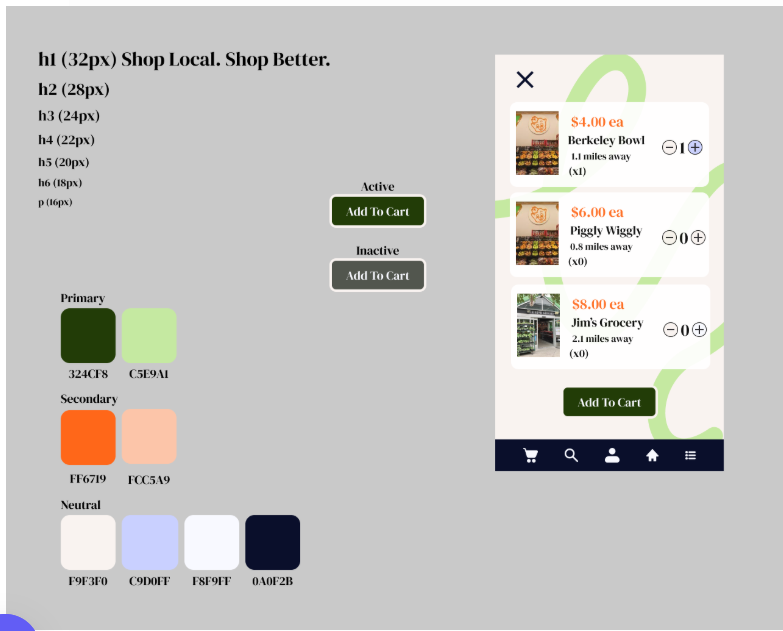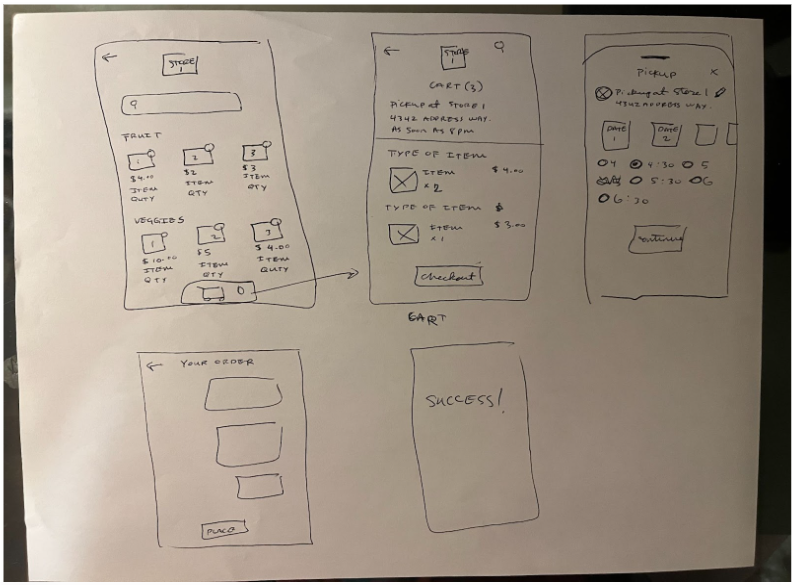Shop Local
ROLE
Product Design
DURATION
June 2025 – August 2025
OVERVIEW
Shop Local was born out of love for the locally owned businesses I frequented as a child in Altadena, California. The convenience store where my father and I used to buy milk. The nursery where we bought the seedlings for our garden. The hardware store where the cashiers all knew me by name. Each one of these businesses was a childhood landmark.
Not many of these businesses survived the 2025 Eaton fire. Even still, the businesses that remain open face an uphill battle to stay as such. In the wake of the fire, I found myself asking the same question as many Altadenans: how do we keep the local businesses we know and love alive when it is so much easier to buy online?
Meanwhile, in Oakland, California, I witnessed the rise of the BDS movement. Most members of my community began boycotting big box stores in favor of local businesses. And yet, I heard the same question over and over: where do we find the products we need without compromising our conscience or breaking the bank?
Everyone says they love local businesses. The charm, familiarity, and opportunity for face-to-face human interaction you get at a brick and mortar store is impossible to replicate online. And yet, many of the people that want to spend their money at local businesses don’t do so.
THE PROBLEM
MY HYPOTHESIS
Consumers don’t know where to go to get the specific products they need at a price they can afford, so they resort to buying from big box stores.
RESEARCH
GOAL: Find out what obstacles keep consumers from supporting local businesses.
OBJECTIVES:
Find out where, how, and why consumers shop
Discover where, how and why they’d like to shop
Determine if there is a discrepancy between where they shop and where they’d like to shop, and why this discrepancy exists.
COMPETITOR RESEARCH:
I researched the three biggest general store retailers (Amazon, Target, and Walmart) in the US, as well as Google Maps, which people often use to find places to shop. I discovered that Shop Local’s major competitors have a large inventory, implement stellar UX, and are household names. While the third condition is not one that Shop Local could emulate at the time of development, implementing stellar UX and providing access to a wide inventory are achievable – and perhaps essential – factors to consider in the eventual design.
INTERVIEWS:
I conducted phone interviews with five community members aged 24-55, all of whom were interested in shopping locally more often. I found this age bracket to be particularly useful in giving me a big-picture understanding of trends in consumer behavior. Two of my interviewees were mature spenders aged fifty to fifty-five. This demographic of consumer has the most buying power of any other living generation and accounts for more than half of all consumer spending in the U.S. The remaining three interviewees were Gen Z consumers. This demographic of users comprise the largest percentage of the global population and are theoretically on track to spend similarly to their more mature counterparts as they age and accrue more wealth. In interviewing across such a wide age bracket, I gleaned data about well-established consumer expectations as well as contemporary ones.
WHO DID WE TALK TO?
All interviewees want to support local businesses more
All interviewees cite convenience being the main reason they don’t shop locally
All interviewees buy most of their items from big box stores.
All interviewees can’t find specific items they’re looking for at an affordable price anywhere but big box stores.
All interviewees are willing to pay some amount more to shop locally.
4/5 users mentioned needing access to an item within 24 hours as essential for certain items
4/5 users are willing to wait a month for non-necessities to ship to them
3/5 users wish their shopping places were closer to them
WHAT DID WE LEARN?
These common threads are illustrated in the affinity map I compiled post-interviews:
I used the insights distilled from affinity mapping to create our target user archetype: Lawrence. He encompassed all the concerns and desires associated with our target audience, and provided a guiding light to refer back to throughout the design process.
PERSONA:
THE VISION
Shop Local is a a shopping platform that helps users
find local alternatives to big box stores and
streamlines users’ ability to purchase goods from local stores
THE BUSINESS
Shop Local taps into a national market of locally owned brick and mortar retailers that have been largely left behind in the era of one click purchasing. Each store that joins Shop Local would pay an enrollment fee to have their store featured on our platform. From then on, Shop Local would receive a percentage of whatever profit retailers on our site have generated through sales made on the Shop Local app.
Offering users the opportunity to enroll in Shop Local Rewards has the potential to provide a positive experience for business owners, our users, and Shop Local stakeholders. Increasing ease of access for users and incentivizing their continued patronage with exclusive deals would theoretically increase sales at each retailer listed on our platform, thus increasing Shop Local profits.
PRODUCTION
I cross referenced the data from my user interviews with that from my comparative analysis in order to put together a roadmap of the features I’d include in the app.
FEATURE SET
Because many smaller businesses lack the resources to provide the overnight shipping times consumers have come to expect from big-box stores, I decided to keep Shop Local’s scope limited to in-store pickup only. This decision is further supported by the sentiments held by the consumers I interviewed: people who are interested in shopping locally are willing to commute to a brick-and-mortar business as long as it is close to them and purchase time is speedy.
I settled on price compare and search/filters as essential features after looking at the interfaces of Shop Local’s competitors. Users have come to expect the ability to compare prices between stores at a glance through the use of a ranked dollar sign system ($-$$$), and need basic navigation tools such as search filters in order to browse large inventories.
USER FLOW
I created a user flow to help me understand which and how many screens I’d need to design. In order to design a MVP version of shop local, I’d need to design a flow that tested the three most crucial functions of the app
logging in as a returning user
loading the cart
checking out
Now that I knew what screens I’d be designing, I could create a blueprint for the site. Creating a site map at this point in the design process helped solidify my understanding of how all the moving pieces of the app would come together.
SITE MAP
The flow I designed tested users’ experience of logging in as a returning user, loading their cart, and purchasing items.
MOBILE WIREFRAMES
I initially based my design off of Safeway’s single-store pickup options . Later on in the design process, I’d discover that a single-store model would not apply to Shop Local’s use case. Trying to force the single-store purchase model onto early versions of my design let me to truncate steps that I’d later realize would need to be parsed out. More on this later!
Initial testing of the above design went well. All users were able to load their carts with the appropriate items in under two minutes. However, this success was deceiving. The scope of the user testing would later prove not broad enough to account for edge cases associated with real-world use.
MID-FI USER TESTING
Before designing hi-fi wireframes, we needed to establish Shop Local’s brand values and aesthetic. A delicate balance was struck: convenient yet community centric, intentional yet intuitive.
THE BRAND
The primary green shade evokes the community growth Shop Local hopes to facilitate through greater participation in local economies. The bright orange of the secondary palate provides a complementary splash of color alongside the green, inviting playfulness and vitality into the design. The entire palate is grounded in blue, tan, and white neutrals to convey Shop Local’s integrity and trustworthiness.
HI-FI WIREFRAMES AND USABILITY TESTING
I designed my hi-fi wireframes and conducted usability tests with 5 participants. Users were still able to complete the checkout process in under two minutes, and found the overall design pleasing and easy to navigate.
However, upon reassessing my design, it became clear to me that the purchasing process was not streamlined enough. The initial flow I designed required users to search by item, then gave them the option to buy said item from several different stores. While the scope of options provided in this version of the design may have been tantalizing to users, the possibility of being able to buy the same item from several different stores would have ultimately diminished the convenience of pickup. In a real-world scenario where users aren’t following explicit instructions for use, it is highly likely that users would have veered off the “happy path” very early on in the check out process.
Having realized the increased cognitive load my current design imposed on users, I went back to the drawing board and sketched out new ideas for a more efficient flow.
HI-FI ITERATION
I conducted basic user testing with three new participants on the paper wireframes. Users were once again able to easily navigate the checkout process. The difference between this iteration and the one before it lay in its precedent: apps such as Instacart and DoorDash gate users into a specific path early on in the purchasing process, rather than give them the maximum number of purchasing options up front. I followed this same pattern with my redesign. In this version, I required users to begin their search by looking up a store or type of store, rather than item.
Whereas the first few iterations of Shop Local’s design were based off the design conventions of the apps for its brick-and-mortar competitors, this new iteration would draw its biggest inspiration from Instacart. In retrospect, it was clear that Instacart’s model fit Shop Local’s use case much better than previous contenders because it houses a similar amount of inventory and breadth of stores as Shop Local.
This project reinforced for me the importance of empathizing with users throughout the design process. Having streamlined the Shop Local purchase process, I now understand a basic tenet of design: don’t give users options you don’t want them to try. While it is an edge case for a user to decide to buy items form several different stores and compromise their shopping experience just out of curiosity, I should take that possibility seriously and work to avoid it as early as possible in the design process.
A helpful technique for refining design systems early on would be to think more generatively during the early phases of design. Sketching out more ideas for the same process might have led me to realize the flaw in my initial deign much sooner, and without the loss of time spent fleshing out a not-so-usable design as a Hi-Fi prototype.
LEARNING, REFLECTION, AND GROWTH
NEXT STEPS
Given the opportunity to expand the Shop Local project, I would design a feature that is unanimous across our competitors’ platforms: a rewards program. A rewards program has a great potential to increase profits for Shop Local and participating businesses alike. The familiarity of a rewards feature (see “Surprise And Delight” on my feature roadmap) would also increase credibility to our users, many of whom might be skeptical about trying a new shopping platform.
KEY TAKEAWAYS
With Shop Local, users can balance the convenience of online shopping with the intentionality of buying small. We aim to help revitalize the small business sector and empower users to make value-centered purchases without breaking the bank.













